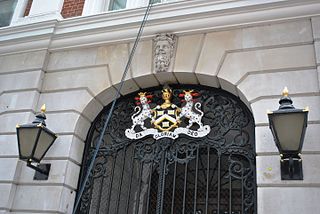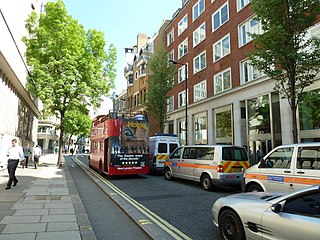Related Research Articles

The Worshipful Company of Dyers is one of the Livery Companies of the City of London. The Dyers' Guild existed in the twelfth century; it received a Royal Charter in 1471. It originated as a trade association for members of the dyeing industry but is now mainly a charitable institution. Each year the company participates in the ceremony of Swan Upping along the River Thames.

The London Encyclopaedia, first published in 1983, is a 1100-page historical reference work on the United Kingdom's capital city, London. The encyclopaedia covers the Greater London area.

The River Neckinger is a reduced subterranean river that rises in Southwark and flows approximately 2.5 kilometres through that part of London to St Saviour's Dock where it enters the Thames. What remains of the river is enclosed and runs underground and most of its narrow catchment has been diverted into other combined and surface water sewers, flowing into the Southern Outfall Sewer and the Thames respectively.

Woolverstone Hall is a large country house, now in use as a school and available at times as a function venue, located 5 miles (8.0 km) south of the centre of Ipswich, Suffolk, England. It is set in 80 acres (320,000 m2) on the banks of the River Orwell. Built in 1776 for William Berners by the architect John Johnson of Leicestershire, it is an outstanding example of English Palladian architecture and is a Grade I listed building while associated buildings are Grade II. From 1951 to 1990, it housed Woolverstone Hall School, a boarding school operated by London County Council (LCC).

St Paul's Church, Shadwell, is a Grade II* listed Church of England church, located between The Highway and Shadwell Basin, on the edge of Wapping, in the East End of London, England. The church has had varying fortunes over many centuries, and is now very active, having been supported recently by Holy Trinity Brompton Church.

Brook Street is an axial street in the exclusive central London district of Mayfair. Most of it is leasehold, paying ground rent to and seeking lease renewals from the reversioner, that since before 1800, has been the Grosvenor Estate. Named after the Tyburn that it crossed, it was developed in the first half of the 18th century and runs from Hanover Square to Grosvenor Square. The western continuation is called Upper Brook Street; its west end faces Brook Street Gate of Hyde Park. Both sections consisted of neo-classical terraced houses, mostly built to individual designs. Some of them were very ornate, finely stuccoed and tall-ceilinged, designed by well known architects for wealthy tenants, especially near Grosvenor Square, others exposed good quality brickwork or bore fewer expensive window openings and embellishments. Some of both types survive. Others have been replaced by buildings from later periods.

Finsbury Circus is a park in the Coleman Street Ward of the City of London, England. The 2.2 hectares park is the largest public open space within the City's boundaries.
Henry Benjamin Wheatley FSA was a British author, editor, and indexer. His London Past and Present was described as his most important work and "the standard dictionary of London".
St Mary Axe was a mediaeval church in the City of London. Its full name was St Mary, St Ursula and her 11,000 Virgins, and it was also sometimes referred to as St Mary Pellipar. Its common name derives from the sign of an axe over the east end of the church. The church's patrons were the Skinners' Company.

The Liberty of the Rolls was a liberty, and civil parish, in the metropolitan area of London, England.

St Mildred, Poultry, was a parish church in the Cheap ward of the City of London dedicated to Anglo-Saxon Saint Mildred. It was rebuilt after the Great Fire of London, and demolished in 1872. St Mildred in the Poultry was the burial place of the writer Thomas Tusser. Some description of the church and its monuments is given in John Stow's Survey of London.

Paper Buildings are a set of chambers located in the Inner Temple in Temple, London. They were initially constructed in 1609. Paper Buildings appear in A Tale of Two Cities and Barnaby Rudge.

Marylebone is a district in the West End of London, in the City of Westminster. Oxford Street, Europe's busiest shopping street, forms its southern boundary.

Petty France is a street in the City of Westminster in central London, linking Buckingham Gate with Broadway and Queen Anne's Gate.

Nando's was a coffee house in Fleet Street in London. It was known to exist in 1696, being the subject of a conveyance, and was popular in the 18th century, especially with the legal profession in the nearby courts and chambers.

Vigo Street is a short street in central London that is named after the Anglo-Dutch naval victory over the French and Spanish in the 1702 Battle of Vigo Bay. It has important literary connections.

A bronze statue of Henry Havelock by the sculptor William Behnes, stands in Trafalgar Square in London, United Kingdom. It occupies one of the four plinths in Trafalgar Square, the one to the southeast of Nelson's Column.

Great Cumberland Place is a street in the City of Westminster, part of Greater London, England. There is also a hotel bearing the same name on the street.

D'Arblay Street is a street in the Soho district of the City of Westminster, London, named after Frances Burney. It was formerly known as Portland Street and was built on land owned by the Dukes of Portland known as Doghouse Close.
James Thorne (1815–1881) was an English antiquary, best known for his Handbook to the Environs of London (1876).
References
- ↑ "The London Topographical Society: A brief account" by Stephen Marks in The London Topographical Record , 1980, pp. 1-10.